Ultimate Guide on Pergola Outdoor Kitchen
Outdoor kitchens are the ultimate addition to modern homes, offering a perfect blend of functionality and aesthetics for al fresco dining and entertaining. Adding a pergola to your outdoor kitchen elevates the experience by providing shade, structure, and style. In this blog, we will explore stunning pergola outdoor kitchen design ideas, planning, building, and maintenance guides.
Table of Contents
Why Add a Pergola to Your Outdoor Kitchen?
A pergola offers multiple benefits beyond aesthetics:
- Shade and Comfort
- Keeps the cooking and dining areas cooler by reducing direct sunlight.
- Enhances comfort for guests, especially during sunny days.
- Weather Protection
- With added features like retractable canopies or curtains, pergolas can shield against light rain or wind.
- Defined Spaces
- Creates a distinct area for cooking, dining, and lounging within your backyard.
- Customization Potential
- Pergolas can be designed to match your home’s architecture or personal style with endless material and accessory options.
Also read: The Ultimate Guide to Outdoor Kitchen Sinks
Design Considerations for a Pergola Outdoor Kitchen
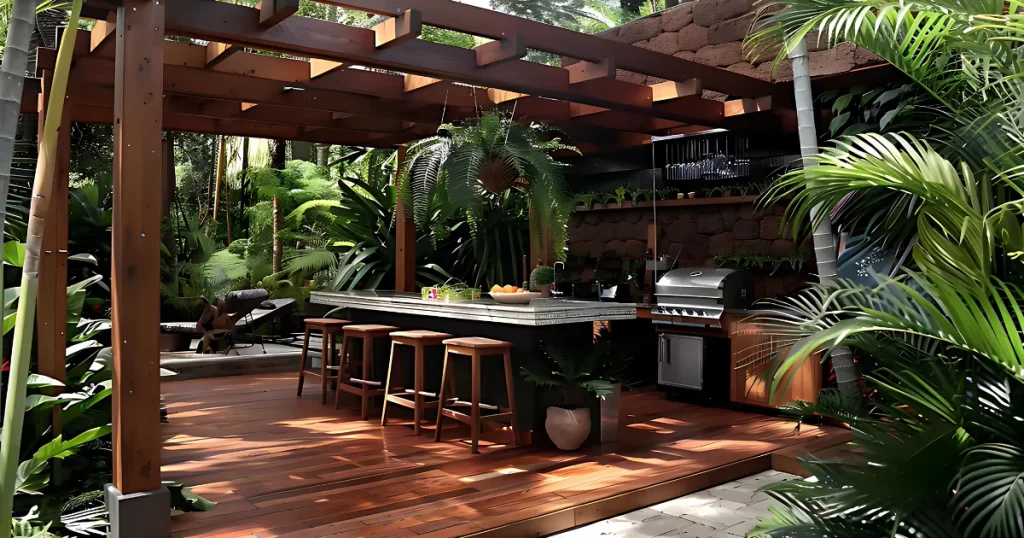
Before diving into design ideas, consider these factors:
- Material Choice
- Wood: Offers a classic, natural look but requires regular maintenance.
- Metal (Aluminum or Steel): Sleek, modern, and durable with minimal upkeep.
- Vinyl: Affordable and weather-resistant, but less customizable.
- Size and Placement
- Choose a pergola size proportional to your outdoor kitchen.
- Position it strategically to maximize natural light and airflow while minimizing sun exposure.
- Integration with Kitchen Layout
- Ensure the pergola design complements the style of your countertops, appliances, and seating areas.
- Lighting and Accessories
- Incorporate string lights, pendant lights, or chandeliers to create ambiance.
- Add fans, misters, or heaters to maintain comfort in all weather conditions.
Stunning Pergola Outdoor Kitchen Design Ideas
1. Rustic Elegance with Wooden Pergolas
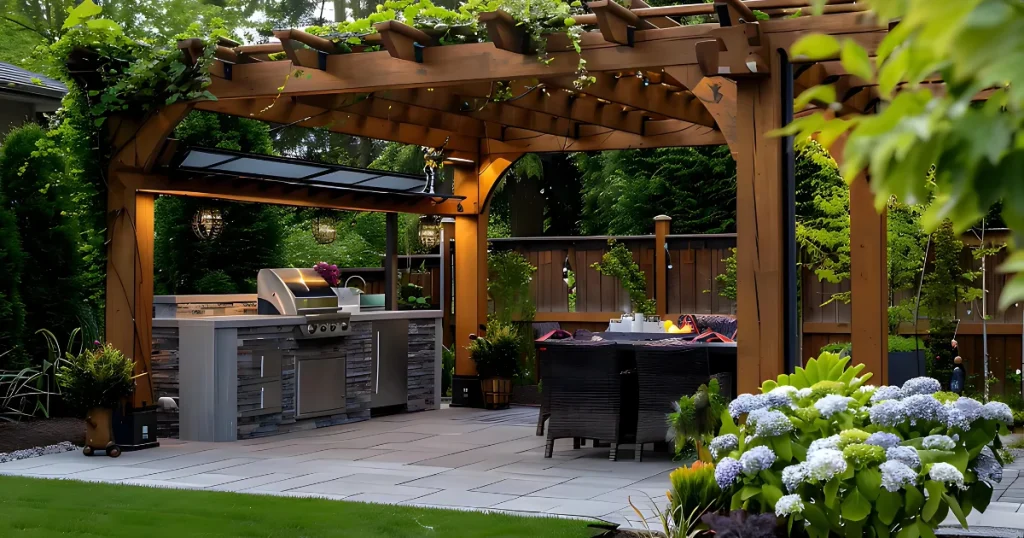
- Inspiration: A natural wood pergola paired with a stone or brick outdoor kitchen.
- Features:
- Exposed wooden beams for a rustic charm.
- Hanging lanterns or Edison bulb string lights for soft evening illumination.
- Wooden bar stools and a farmhouse-style dining table.
- Best For: Homes with a traditional or country-style aesthetic.
2. Modern Minimalist Designs
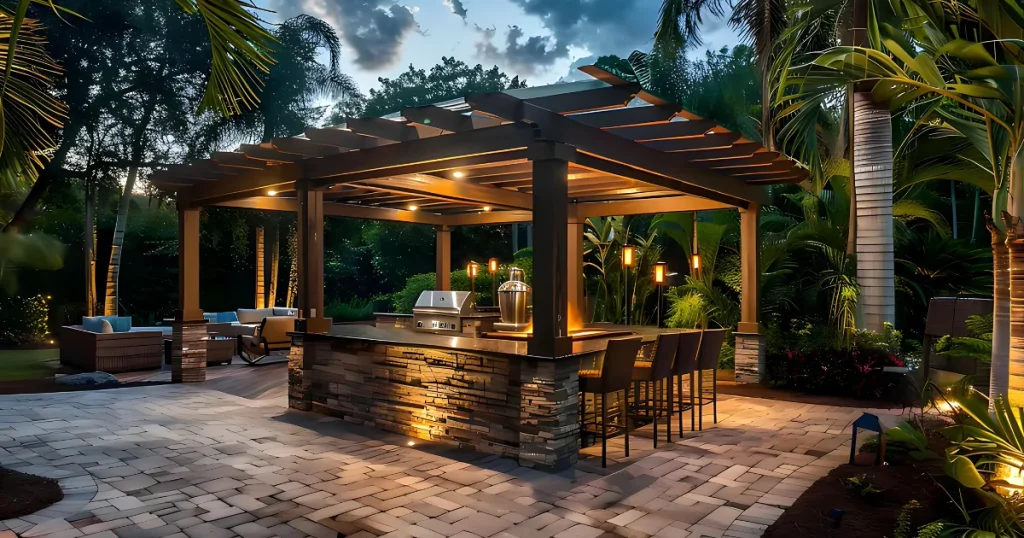
- Inspiration: A sleek, aluminum pergola with clean lines over a modern outdoor kitchen.
- Features:
- Monochromatic color schemes with stainless steel appliances and quartz countertops.
- Integrated LED strip lighting for a futuristic look.
- Minimal furniture with neutral tones and sharp angles.
- Best For: Contemporary or urban settings.
3. Mediterranean Escape
- Inspiration: A white pergola with climbing greenery over a terracotta-inspired kitchen.
- Features:
- Mediterranean tiles for countertops and backsplash.
- Wrought-iron furniture and soft cushions in earthy tones.
- Plants like bougainvillea or grapevines for a lush, natural canopy.
- Best For: Coastal homes or Mediterranean-themed landscapes.
4. All-Weather Pergola with Retractable Roof
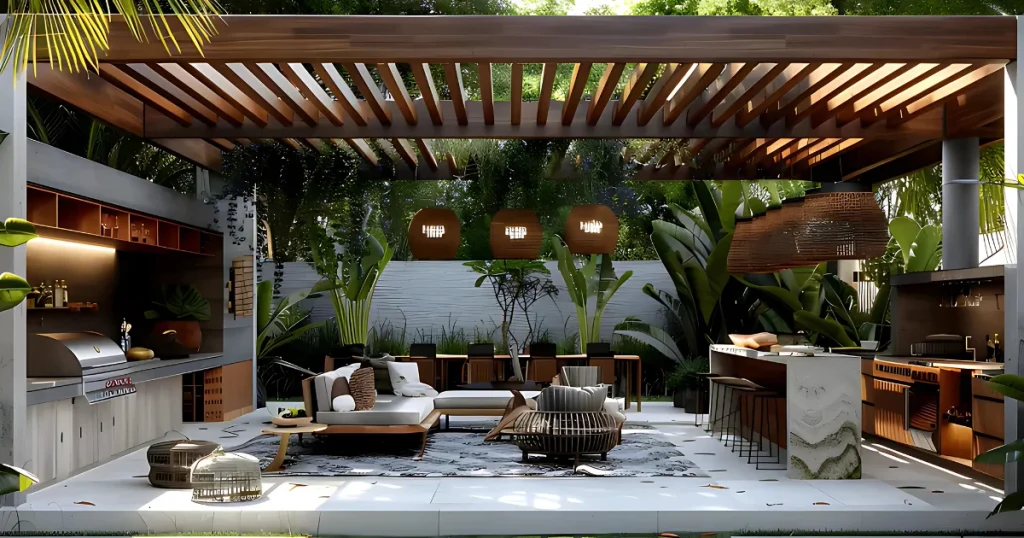
- Inspiration: A pergola equipped with a retractable or louvered roof for versatility.
- Features:
- Adjustable louvers for controlling sunlight and ventilation.
- Integrated rain gutters for weather protection.
- Modern outdoor furniture with weather-resistant fabrics.
- Best For: Areas with unpredictable weather.
5. Industrial Chic Outdoor Kitchen
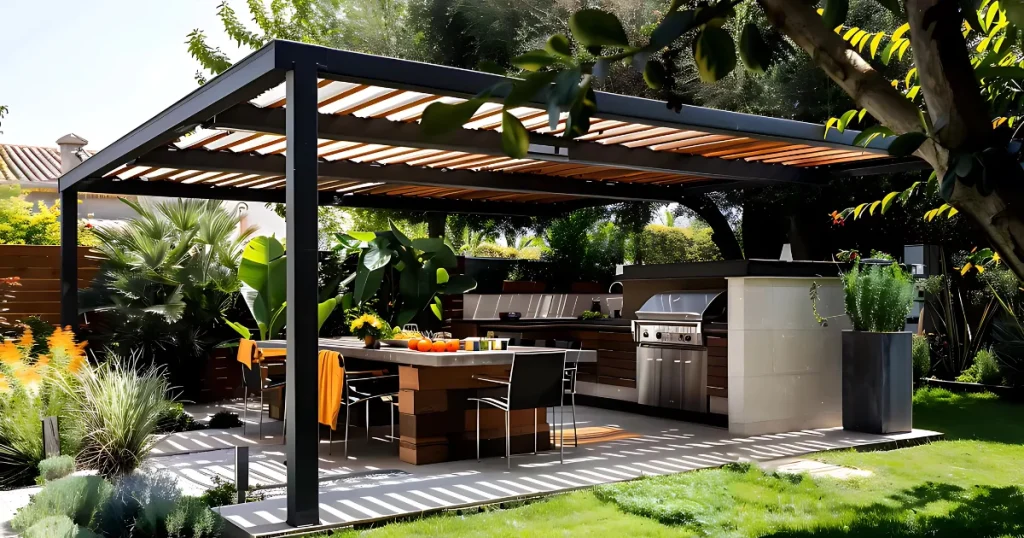
- Inspiration: A metal pergola with a raw, industrial vibe over an urban-style kitchen.
- Features:
- Steel or iron pergola frames paired with concrete countertops and exposed brick walls.
- Edison bulb pendant lights and bar stools with metal finishes.
- Open shelving for an uncluttered, functional aesthetic.
- Best For: Industrial lofts or urban backyards.
6. Coastal Retreat with a Nautical Theme
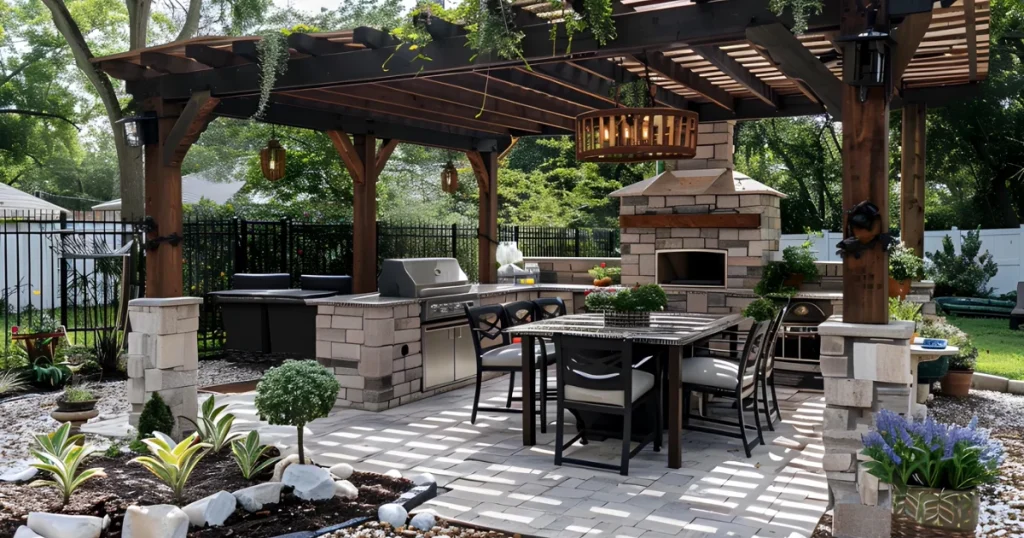
- Inspiration: A pergola designed with whitewashed wood and rope accents.
- Features:
- Outdoor kitchen cabinets in light blues or whites.
- Nautical-inspired pendant lights and accessories.
- Soft, weatherproof cushions in navy and white stripes.
- Best For: Beachfront or coastal properties.
7. Tropical Oasis with Lush Greenery
- Inspiration: A bamboo or teak pergola surrounded by tropical plants and vibrant colors.
- Features:
- Outdoor kitchen with granite or dark wood countertops.
- Overhead fans for cooling in humid climates.
- Plants like palms, ferns, and orchids to enhance the tropical ambiance.
- Best For: Homes in warm, tropical climates.
8. Pergola with Integrated Entertainment
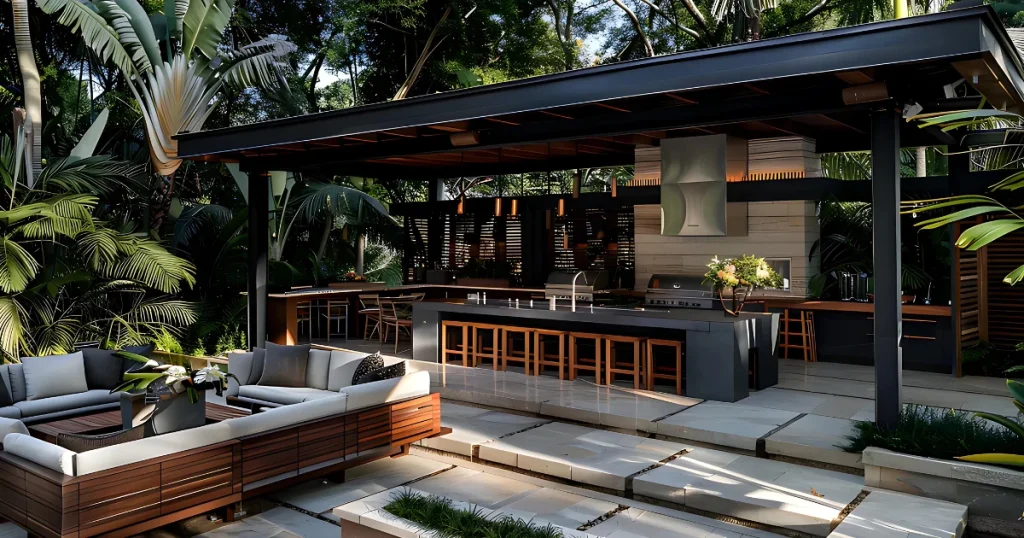
- Inspiration: A multi-functional pergola for cooking, dining, and entertainment.
- Features:
- Built-in speakers and outdoor TV for entertainment.
- Bar-style seating with a built-in beverage cooler.
- Fire pit or outdoor fireplace for cozy gatherings.
- Best For: Hosting parties and family get-togethers.
Guide to Planning and Designing a Pergola Outdoor Kitchen
A pergola outdoor kitchen can transform your backyard into a functional, stylish space for cooking and entertaining. Here’s a step-by-step guide to help you plan and design the perfect pergola outdoor kitchen.
1. Choosing the Right Location and Size
Assess the Space
- Backyard Layout: Identify an area with enough space for the kitchen, seating, and movement.
- Proximity to the House: Place the kitchen close to your indoor kitchen for easy access to utilities and supplies.
Consider Environmental Factors
- Sunlight and Shade: Position the pergola to provide optimal shade during peak sun hours.
- Wind Direction: Align cooking appliances like grills to minimize smoke blowing into seating areas.
- Drainage: Ensure the area is well-drained to avoid water pooling during rain.
Determine the Size
- Kitchen Size: Plan based on your cooking and entertaining needs; a small setup may include just a grill and countertop, while a larger one may have multiple appliances.
- Pergola Dimensions: The pergola should comfortably cover the kitchen and any dining or seating areas.
2. Selecting Materials for the Pergola and Kitchen
Pergola Materials
- Wood: Offers a natural, rustic look; use treated wood for durability and weather resistance.
- Aluminum: Lightweight, rustproof, and low-maintenance; ideal for modern designs.
- Vinyl: Durable and budget-friendly, though it offers limited customization options.
- Steel: Provides a sleek, industrial aesthetic and excellent durability.
Kitchen Countertops
- Granite: Heat-resistant and durable, perfect for outdoor use.
- Concrete: Customizable and weatherproof, but may require sealing.
- Tile: Cost-effective but can be prone to cracking in extreme temperatures.
Cabinets and Storage
- Stainless Steel: Resistant to rust, ideal for all-weather use.
- Teak or Cedar: Weather-resistant woods that add a warm, natural touch.
- PVC or Marine-Grade Polymer: Waterproof and low-maintenance.
3. Planning the Layout and Functionality of the Kitchen
Choose a Functional Layout
- L-Shaped Layout: Provides ample counter space and room for appliances.
- U-Shaped Layout: Great for larger kitchens, with dedicated zones for prep, cooking, and serving.
- Straight-Line Layout: Compact and efficient, ideal for small spaces.
Integrate Key Zones
- Cooking Zone: Include a grill, smoker, or pizza oven.
- Prep Zone: Allocate counter space for chopping, mixing, and marinating.
- Cleaning Zone: Install a sink for washing hands, dishes, and produce.
- Serving Zone: Add a bar counter or serving table for seamless dining.
Ensure Utility Access
- Water Supply: Plan for plumbing if adding a sink or dishwasher.
- Electricity: Install outlets for appliances like blenders, refrigerators, or outdoor heaters.
- Gas Lines: For built-in grills or stovetops, ensure professional installation of gas connections.
4. Incorporating Lighting and Other Design Elements
Lighting
- Task Lighting: Use under-cabinet or pendant lights for cooking and prep areas.
- Ambient Lighting: Add string lights, recessed lighting, or lanterns for a cozy atmosphere.
- Accent Lighting: Highlight architectural features of the pergola with LED strips or spotlights.
Weather Protection
- Retractable Canopies: Provide adjustable shade and rain protection.
- Polycarbonate Roof Panels: Offer UV protection while allowing natural light.
- Curtains or Screens: Add privacy and block wind or insects.
Design Features
- Climbing Plants: Grow vines like wisteria or ivy on the pergola for a natural, elegant look.
- Built-In Features: Include shelves, hooks, or racks for storing utensils and spices.
- Outdoor Seating: Use weatherproof furniture and arrange seating to encourage conversation.
Appliance Selection
- Weatherproof Appliances: Opt for outdoor-rated grills, refrigerators, and dishwashers.
- Smart Features: Consider Wi-Fi-enabled appliances for modern convenience.
5. Budget and Future Expansion
Set a Budget
- Allocate funds for materials, appliances, and professional installations.
- Plan for hidden costs like permits, plumbing, or utility extensions.
Plan for Growth
- Design a flexible layout that allows for future additions, such as more seating, upgraded appliances, or extra storage.
Pro Tip:
Work with a professional contractor or designer to ensure the pergola and kitchen are safe, functional, and compliant with local building codes.
By carefully planning each element, your pergola outdoor kitchen will become a stunning, functional centerpiece for cooking, entertaining, and enjoying the outdoors.
Building Your Own Pergola Kitchen: Step-by-Step Guide
Constructing your pergola kitchen is a rewarding project that adds value and functionality to your outdoor space. Follow this detailed guide for a successful DIY build, complete with tips on tools, safety, and overcoming common challenges.
1. Planning and Designing Your Pergola Kitchen
Determine Your Needs
- Purpose: Define whether the space will primarily be for cooking, entertaining, or both.
- Size: Measure your available space to determine the pergola dimensions and kitchen layout.
- Utilities: Decide if you need plumbing, gas, or electrical connections.
Create a Blueprint
- Sketch a detailed plan showing the pergola structure, kitchen appliances, and seating areas.
- Include measurements for post spacing, countertop height, and any built-in features like cabinets.
2. Choosing the Right Tools and Materials
Essential Tools
- Measuring Tools: Tape measure, level, and carpenter’s square.
- Cutting Tools: Circular saw, miter saw, or handsaw for wood or metal.
- Fastening Tools: Cordless drill, screws, bolts, and a wrench.
- Concrete Tools: Shovel and trowel for setting posts.
Materials for the Pergola
- Wood: Cedar or pressure-treated lumber for a natural, durable frame.
- Metal: Aluminum or steel for a modern, low-maintenance structure.
- Vinyl: Lightweight and easy to maintain, but less customizable.
Materials for the Kitchen
- Countertops: Choose weatherproof options like granite, concrete, or stainless steel.
- Cabinets: Use marine-grade polymer or stainless steel to withstand outdoor conditions.
- Flooring: Opt for pavers, concrete, or outdoor-rated tiles for durability.
3. Following Building Codes and Safety Guidelines
Check Local Regulations
- Obtain permits if required for outdoor structures, plumbing, or electrical work.
- Confirm zoning restrictions and property line setbacks.
Ensure Structural Safety
- Post Anchoring: Use concrete footings or metal post anchors to stabilize the pergola.
- Weight Capacity: Account for the weight of appliances, countertops, and overhead fixtures.
- Wind Resistance: Reinforce with hurricane ties or cross beams if in a windy area.
Work Safely
- Wear protective gear, including gloves, safety glasses, and sturdy footwear.
- Avoid working in extreme weather conditions to reduce risk of injury.
4. Building the Pergola Structure
Step 1: Mark and Dig Post Holes
- Use stakes and string to mark the pergola’s footprint.
- Dig holes for the support posts, typically 12-18 inches deep.
Step 2: Install the Posts
- Place posts in the holes and secure with concrete.
- Use a level to ensure the posts are vertical before the concrete sets.
Step 3: Attach the Beams and Rafters
- Fasten horizontal beams to the top of the posts using bolts or brackets.
- Space rafters evenly across the beams for proper support and aesthetic balance.
Step 4: Add Finishing Touches
- Sand and seal wood surfaces to prevent weather damage.
- Install decorative elements like lattice panels or a retractable canopy.
5. Constructing the Outdoor Kitchen
Step 1: Install the Countertops and Cabinets
- Build a sturdy frame using treated lumber or metal.
- Attach countertops securely and seal them for weather resistance.
Step 2: Set Up Appliances
- Position grills, sinks, or refrigerators according to your layout.
- Connect plumbing and electrical systems, ensuring they meet safety standards.
Step 3: Add Finishing Elements
- Install backsplash tiles or weatherproof panels for style and functionality.
- Include storage features like drawers, hooks, and shelves.
6. Incorporating Lighting and Design Elements
Install Lighting
- Use waterproof fixtures for task and ambient lighting.
- Add LED strip lights under countertops or rafters for a modern touch.
Decorate Thoughtfully
- Hang string lights or lanterns for a cozy vibe.
- Incorporate plants and outdoor furniture to enhance the aesthetic.
7. Troubleshooting Common Challenges
Uneven Ground
- Use leveling tools and shims to create a stable foundation for posts and countertops.
Weather Delays
- Cover materials and tools with tarps to protect them during rain.
- Schedule major construction tasks during a dry season.
Utility Installation Issues
- Work with licensed professionals to avoid plumbing or electrical mistakes.
- Test all connections before fully enclosing pipes or wiring.
Material Durability
- Seal wood regularly to prevent rot or warping.
- Inspect metal parts for rust and touch up with weatherproof paint if needed.
Pro Tips for Success
- Take Your Time: Rushing can lead to mistakes; plan for extra time in case of unexpected challenges.
- Get Help: Enlist a friend or family member to assist with lifting heavy beams or assembling large components.
- Stick to the Plan: Follow your blueprint to ensure the final product matches your vision.
By following this guide, you’ll create a pergola kitchen that’s not only functional but also a beautiful centerpiece for your outdoor living space!
How to Style Your Pergola Outdoor Kitchen
1. Furniture and Seating
- Add bar stools or lounge chairs for a casual vibe.
- Opt for durable, weather-resistant materials like teak or aluminum.
2. Lighting Enhancements
- Use hanging pendant lights for task lighting.
- Install string lights or fairy lights for a warm, inviting glow.
3. Accessories and Décor
- Add outdoor rugs and cushions to enhance comfort.
- Use potted plants or vertical gardens for greenery and vibrancy.
Maintenance Tips for Pergola Outdoor Kitchens
Maintaining your pergola and outdoor kitchen ensures they remain functional, durable, and visually appealing for years. Follow these tips for cleaning, protecting, and repairing your pergola and kitchen components effectively.
1. Cleaning and Maintenance Routines
Pergola Structure
- Wooden Pergola:
- Clean annually with a mild soap-and-water solution to remove dirt, mildew, and stains.
- Sand rough or splintered areas and reapply a protective sealant or stain every 1–2 years.
- Metal Pergola:
- Wipe down with a damp cloth to remove dust and debris.
- Check for rust, and treat spots with rust-resistant paint.
- Vinyl Pergola:
- Spray with a garden hose or clean with a soft brush and soapy water.
- Avoid abrasive scrubbers that could scratch the surface.
Outdoor Kitchen Components
- Countertops:
- Granite: Clean with warm water and a pH-neutral cleaner. Avoid acidic cleaners that can damage the surface.
- Stainless Steel: Wipe with a microfiber cloth and a stainless-steel cleaner to prevent streaks.
- Concrete: Seal every 1–2 years to prevent stains and cracks.
- Appliances:
- Grills: Clean grates after every use and perform a deep clean monthly to remove grease buildup.
- Refrigerator: Defrost periodically, and clean the interior with a mild detergent.
- Sink: Flush with hot water regularly and clean with non-abrasive cleaners.
2. Protecting the Pergola from Weather Damage
General Weatherproofing
- Sealants and Stains: Apply water-resistant sealants or weatherproof stains to wooden pergolas to protect against rain and UV rays.
- Rust Prevention: Use rust-proof coatings on metal pergolas to shield against moisture.
- UV Protection: Install a retractable canopy or shade cloth to reduce sun exposure, which can fade materials.
Seasonal Preparations
- Rainy Seasons: Ensure proper drainage around the pergola and cover furniture with waterproof covers.
- Winter: Remove snow buildup on the pergola to prevent structural strain. Store movable kitchen components, like portable grills or utensils, indoors.
- Windy Conditions: Secure pergola attachments, such as string lights or hanging decor, to prevent damage during high winds.
3. Repairing and Replacing Parts as Needed
Pergola Repairs
- Wooden Pergola:
- Replace rotted or cracked beams promptly to maintain structural integrity.
- Tighten or replace loose screws and nails to avoid wobbling.
- Metal Pergola:
- Sand and repaint rusted sections to prevent further corrosion.
- Check for dents or bent frames, and repair or replace damaged pieces.
- Vinyl Pergola:
- Repair small cracks with vinyl adhesive. For significant damage, replace the affected panels or posts.
Kitchen Component Repairs
- Countertops:
- Fill small cracks in concrete with a patching compound.
- Buff out scratches on granite or stainless steel with appropriate repair kits.
- Appliances:
- Fix gas leaks or burner issues in grills by replacing faulty parts, such as ignition switches or burners.
- Replace worn refrigerator seals to maintain efficiency.
- Plumbing:
- Address leaks in the sink or water lines by tightening connections or replacing faulty parts.
4. Long-Term Maintenance Tips
- Regular Inspections:
- Inspect the pergola and kitchen components monthly for signs of wear, damage, or pests.
- Address minor issues immediately to avoid costly repairs later.
- Pest Control:
- Treat wooden pergolas with insect-resistant coatings to deter termites and carpenter ants.
- Keep the kitchen clean to prevent attracting pests like rodents or insects.
- Re-sealing and Painting:
- Reapply sealants or paint as needed, typically every 2–3 years, depending on weather exposure.
- Upgrade Parts:
- Invest in higher-quality, weather-resistant components for long-term durability, such as stainless steel appliances or composite wood pergola materials.
Pro Tips for Durability
- Seasonal Covers: Use pergola covers or tarps during extended periods of harsh weather.
- Professional Inspections: Hire a professional once a year to check for structural issues or deep cleaning needs.
- Maintenance Calendar: Create a maintenance schedule to track cleaning, sealing, and repairs for both the pergola and kitchen.
By following these care guidelines, your pergola kitchen will remain a beautiful and functional centerpiece of your outdoor space for years to come.
FAQs About Pergola Outdoor Kitchens
- What is the best material for a pergola?
Wood, aluminum, and steel are popular options. Choose based on your style preferences and climate conditions. - Can I install a pergola over an existing outdoor kitchen?
Yes, many pergolas are customizable to fit over existing setups. - How do I maintain a pergola?
Regularly clean and treat wood pergolas and inspect metal structures for rust or wear. - Are pergolas weatherproof?
While pergolas provide some protection, adding a canopy or louvers can make them more weather-resistant. - Can I include appliances under a pergola?
Absolutely. Just ensure proper ventilation and weatherproofing for appliances. - What’s the average cost of a pergola outdoor kitchen?
Costs vary widely based on materials and features but generally range from $10,000 to $30,000.
Final Thoughts
A pergola can transform your outdoor kitchen into a stylish and functional space for cooking and entertaining. Whether you prefer rustic charm, modern minimalism, or tropical vibes, there’s a pergola design to suit every taste.
Ready to start designing your dream outdoor kitchen? Use these ideas as inspiration and create a space that perfectly balances comfort, beauty, and practicality.
Resource: Ultimate Outdoor Kitchen Pergolas
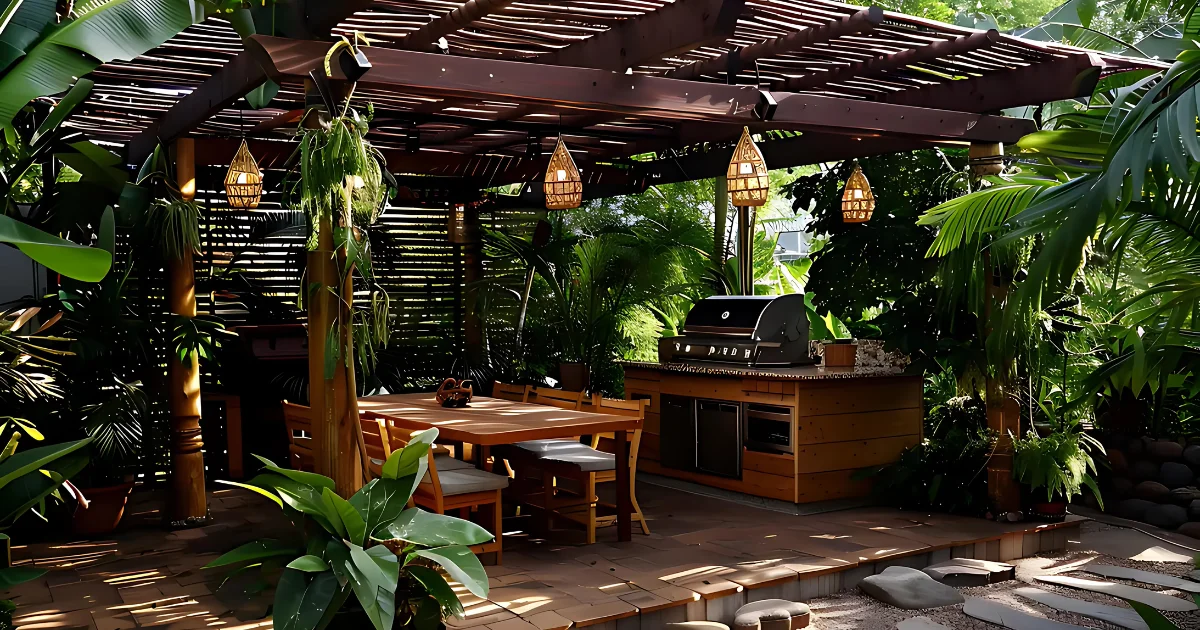
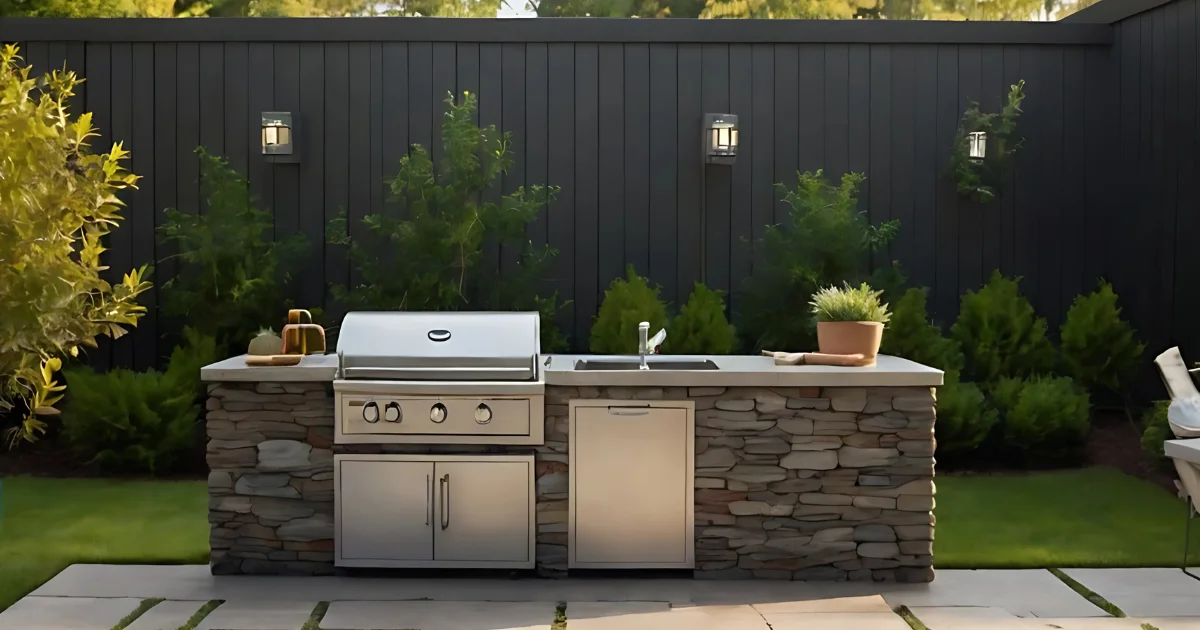
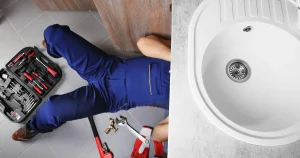
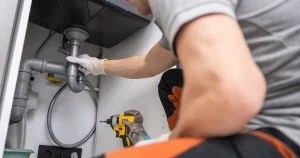


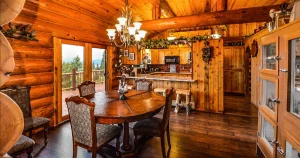
Post Comment